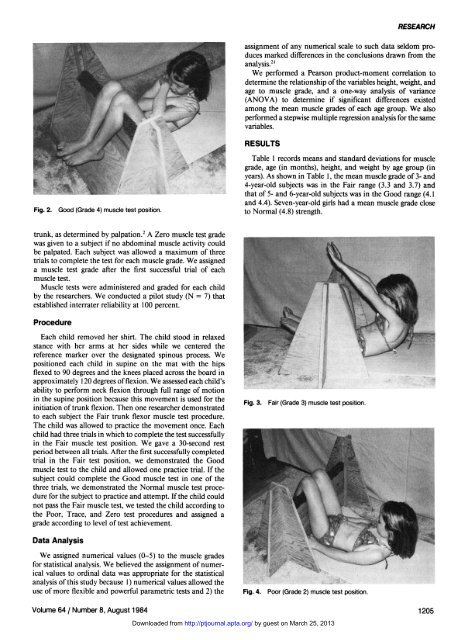Clinical Assessment of Trunk Flexor Muscle Strength in Healthy Girls ...
Clinical Assessment of Trunk Flexor Muscle Strength in Healthy Girls ...
Clinical Assessment of Trunk Flexor Muscle Strength in Healthy Girls ...
You also want an ePaper? Increase the reach of your titles
YUMPU automatically turns print PDFs into web optimized ePapers that Google loves.
Fig. 2. Good (Grade 4) muscle test position.<br />
trunk, as determ<strong>in</strong>ed by palpation. 2 A Zero muscle test grade<br />
was given to a subject if no abdom<strong>in</strong>al muscle activity could<br />
be palpated. Each subject was allowed a maximum <strong>of</strong> three<br />
trials to complete the test for each muscle grade. We assigned<br />
a muscle test grade after the first successful trial <strong>of</strong> each<br />
muscle test.<br />
<strong>Muscle</strong> tests were adm<strong>in</strong>istered and graded for each child<br />
by the researchers. We conducted a pilot study (N = 7) that<br />
established <strong>in</strong>terrater reliability at 100 percent.<br />
Procedure<br />
Each child removed her shirt. The child stood <strong>in</strong> relaxed<br />
stance with her arms at her sides while we centered the<br />
reference marker over the designated sp<strong>in</strong>ous process. We<br />
positioned each child <strong>in</strong> sup<strong>in</strong>e on the mat with the hips<br />
flexed to 90 degrees and the knees placed across the board <strong>in</strong><br />
approximately 120 degrees <strong>of</strong> flexion. We assessed each child's<br />
ability to perform neck flexion through full range <strong>of</strong> motion<br />
<strong>in</strong> the sup<strong>in</strong>e position because this movement is used for the<br />
<strong>in</strong>itiation <strong>of</strong> trunk flexion. Then one researcher demonstrated<br />
to each subject the Fair trunk flexor muscle test procedure.<br />
The child was allowed to practice the movement once. Each<br />
child had three trials <strong>in</strong> which to complete the test successfully<br />
<strong>in</strong> the Fair muscle test position. We gave a 30-second rest<br />
period between all trials. After the first successfully completed<br />
trial <strong>in</strong> the Fair test position, we demonstrated the Good<br />
muscle test to the child and allowed one practice trial. If the<br />
subject could complete the Good muscle test <strong>in</strong> one <strong>of</strong> the<br />
three trials, we demonstrated the Normal muscle test procedure<br />
for the subject to practice and attempt. If the child could<br />
not pass the Fair muscle test, we tested the child accord<strong>in</strong>g to<br />
the Poor, Trace, and Zero test procedures and assigned a<br />
grade accord<strong>in</strong>g to level <strong>of</strong> test achievement.<br />
Data Analysis<br />
We assigned numerical values (0-5) to the muscle grades<br />
for statistical analysis. We believed the assignment <strong>of</strong> numerical<br />
values to ord<strong>in</strong>al data was appropriate for the statistical<br />
analysis <strong>of</strong> this study because 1) numerical values allowed the<br />
use <strong>of</strong> more flexible and powerful parametric tests and 2) the<br />
RESEARCH<br />
assignment <strong>of</strong> any numerical scale to such data seldom produces<br />
marked differences <strong>in</strong> the conclusions drawn from the<br />
analysis. 21<br />
We performed a Pearson product-moment correlation to<br />
determ<strong>in</strong>e the relationship <strong>of</strong> the variables height, weight, and<br />
age to muscle grade, and a one-way analysis <strong>of</strong> variance<br />
(ANOVA) to determ<strong>in</strong>e if significant differences existed<br />
among the mean muscle grades <strong>of</strong> each age group. We also<br />
performed a stepwise multiple regression analysis for the same<br />
variables.<br />
RESULTS<br />
Table 1 records means and standard deviations for muscle<br />
grade, age (<strong>in</strong> months), height, and weight by age group (<strong>in</strong><br />
years). As shown <strong>in</strong> Table 1, the mean muscle grade <strong>of</strong> 3- and<br />
4-year-old subjects was <strong>in</strong> the Fair range (3.3 and 3.7) and<br />
that <strong>of</strong> 5- and 6-year-old subjects was <strong>in</strong> the Good range (4.1<br />
and 4.4). Seven-year-old girls had a mean muscle grade close<br />
to Normal (4.8) strength.<br />
Fig. 3. Fair (Grade 3) muscle test position.<br />
Fig. 4. Poor (Grade 2) muscle test position.<br />
Volume 64 / Number 8, August 1984 1205<br />
Downloaded from<br />
http://ptjournal.apta.org/ by guest on March 25, 2013
















